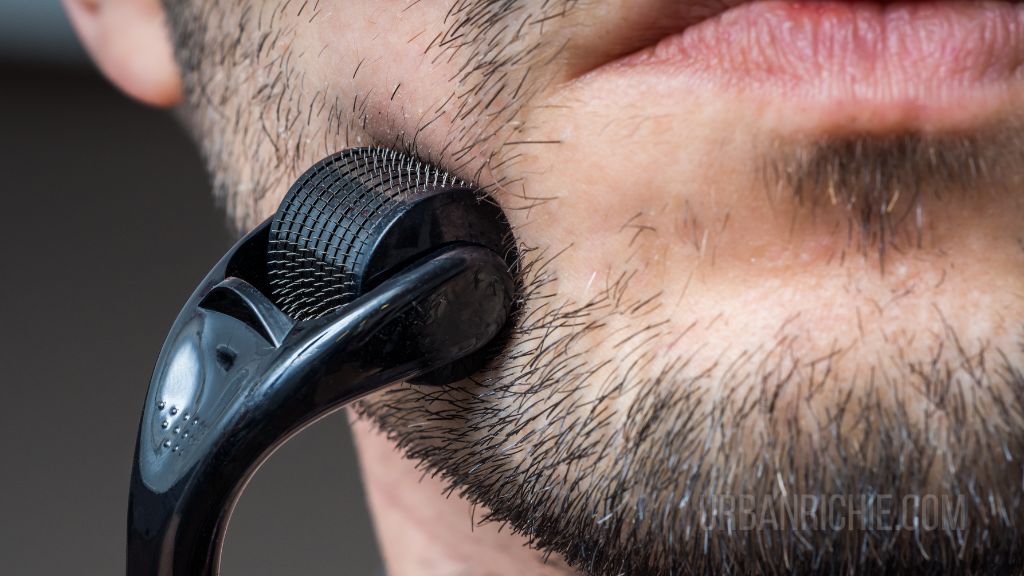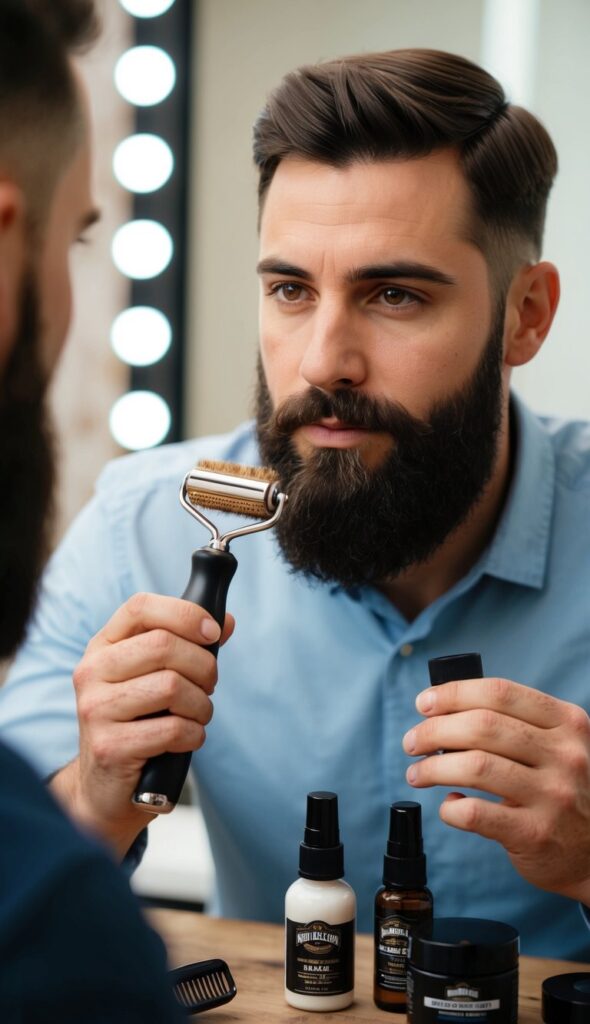Do Beard Rollers Work: Potential Risks And Considerations
If you’ve ever wondered if beard rollers can actually help your facial hair grow, you’re definitely not alone. Lots of folks are searching for answers to patchy or thin beards and are curious if these little tools can make a real difference.
Current evidence points to the idea that using a beard roller might boost your skin’s health and could help stimulate facial hair growth. Still, let’s be real, it’s not a magic fix and won’t work for everyone.
Your genetics have a lot to say about how your beard turns out, and beard rollers won’t rewrite your DNA. That said, some people do notice their beards look fuller after using a roller regularly, especially in those stubborn thin spots.
If you’re thinking about giving it a shot, it’s probably worth seeing what the science says and understanding how to use beard rollers safely. Maybe it’ll fit into your grooming routine, maybe not, but hey, curiosity never hurt anyone
How Beard Rollers Work?

Beard rollers have tiny needles that poke little holes in your skin. The idea is that this boosts blood flow and kicks your skin’s natural repair process into gear.
Rolling properly can wake up hair follicles and make the skin under your beard healthier.
Microneedling Mechanism
When you roll, those micro-needles create tiny injuries on the skin’s surface. Your body responds by starting a healing process.
This reaction ramps up collagen and elastin production. Collagen makes skin stronger and improves texture, while elastin keeps things flexible.
Healthier, more resilient skin is better at supporting hair growth. The micro-injuries can also open up pores, clearing blockages that might get in the way of new hairs.
Beard Growth Stimulation
The small wounds from microneedling get blood pumping to your beard area. More blood means more nutrients and oxygen for your hair follicles—always a good thing.
Microneedling can also help your skin soak up beard oils or serums more efficiently. If you’re using those, you might get better results thanks to the roller.
Still, let’s not get carried away, there’s not a ton of hard science proving beard rollers will give you a full beard. Some guys see changes, some don’t. It really depends on your skin and hair.
Application Procedure
Start with a clean face, seriously, wash off any dirt or oil to dodge infections. Roll the device gently across your beard area.
Go in different directions: up and down, side to side, and diagonally. Don’t press too hard, or you’ll just end up with irritated skin.
After rolling, slap on some beard oil or serum to moisturize and support those follicles. Always clean your roller with alcohol after each use.
Two to three times a week is usually enough. More than that, and you risk redness or irritation. Gentle and steady wins here.
If you want a deep dive into the science, check out Healthline.
Effectiveness of Beard Rollers
Beard rollers are supposed to help your beard by activating hair follicles and improving skin health. But how well they work? That’s a mixed bag, honestly.
Scientific Evidence
There’s not much solid proof that beard rollers alone will turn patchy beards into thick ones. Most studies focus on microneedling for scalp hair, not beards.
Microneedling can boost collagen and blood flow, which is good for hair in general. But that doesn’t always mean you’ll see new or thicker beard growth.
Experts say we need more research here. There’s a good breakdown of the science at Harley Street Hair Clinic.
User Testimonials
Guys who’ve used beard rollers have all sorts of stories. Some say their skin feels better and their beards look fuller after a while. Others? No change, even with regular use.
If you’re going to try it, be ready to play the long game. Consistency, technique, and your own hair growth cycle all matter. User reviews are helpful, but they’re not the same as clinical studies. Want to see what real people say? There are plenty of threads over at Reddit BeardTalk.
Factors Influencing Results
A few things can affect how well a beard roller works for you:
- Skin type: Sensitive or dry skin can react differently to microneedling.
- Frequency: Too much or too little rolling changes your results.
- Needle size: Small needles are gentler; big ones can be riskier.
- Overall health: Hormones, diet, and genetics all play a part.
- Aftercare: Cleaning and moisturizing help keep your skin happy.
Managing these factors gives you a better shot at seeing some benefits. More on this in the Healthline article.
Choosing and Using Beard Rollers

If you want results, picking the right needle size, using the roller at the right frequency, and keeping it clean all matter. Each step impacts how safe and effective the process is for your skin and beard.
Selecting the Right Needle Size
Needle sizes usually range from 0.15 mm up to 1.5 mm. If you’re new or have sensitive skin, stick with 0.25 mm to 0.5 mm.
Those sizes are less painful and less likely to cause damage. Bigger needles, 1 mm or more, go deeper and need more recovery time. Don’t use anything over 1.5 mm at home.
Always pick a roller with stainless steel or titanium needles. Cheap materials can mess up your skin.
Frequency of Use
Don’t roll every day. For 0.25 mm needles, 2-3 times a week is plenty.
If you’re using 0.5 mm, once or twice a week is safer. Larger needles? Give your skin even more time to heal.
Listen to your skin, if it’s irritated, back off. Consistency is way more important than overdoing it.
Maintenance and Hygiene
Cleanliness is non-negotiable. After each use, rinse the roller under hot water, then soak it in 70% isopropyl alcohol for 5-10 minutes.
Never share your roller, seriously, just don’t.
Store it somewhere clean and dry. Replace your roller every 3-6 months, or sooner if the needles get bent or dull.
Good cleaning habits keep your skin safe and the roller working right.
Potential Risks and Considerations

Beard rollers can have side effects, depending on how you use them and your skin type. You’ll want to know the possible risks, whether your skin can handle it, and when it’s better to skip the roller altogether.
Possible Side Effects
Redness, irritation, or swelling are pretty common after using a beard roller. Rolling too hard or too often can damage your skin—think small cuts or bruises.
Overdoing it might even lead to scar tissue, which is the opposite of what you want. If you feel pain or see any sign of infection, stop right away.
Suitability for Different Skin Types
Your skin’s sensitivity changes how it reacts. Sensitive skin? Microneedling might be too much, leading to longer healing times.
Oily skin might handle it better, but clogged pores are still a risk. Dry or flaky skin can get irritated or cracked.
It’s smart to test a small area first. Adjust needle size or frequency if your skin seems unhappy.
When to Avoid Beard Rollers
Skip the beard roller if you have eczema, psoriasis, or bad acne. These up your risk for irritation and infection.
Don’t use it on broken, inflamed, or sunburned skin. If you scar easily or get keloids, it’s probably not for you.
Also, avoid after recent cosmetic skin treatments like chemical peels or laser therapy. Not sure? Check with a dermatologist before starting.
For more safety info, see this Aventus Clinic article on beard roller risks.
Frequently Asked Questions
Beard rollers create tiny holes in your skin to boost blood flow and help your skin stay healthy. How long it takes to see results? That depends on you, and the research isn’t totally settled yet.
How effective are derma rollers in promoting beard growth?
Derma rollers can encourage beard growth by getting more blood to the follicles. This might help your hair come in thicker or healthier, but it’s not a sure thing for everyone. Consistency is key.
What is the typical timeline for seeing results from using a beard roller?
You might notice better skin texture in a few weeks. For actual beard growth, expect to wait 2 to 3 months of regular use, sometimes longer. Everyone’s hair grows at its own pace.
Are there any scientific studies supporting the efficacy of beard rollers for hair regrowth?
There aren’t many scientific studies focused just on derma rollers for beard growth. Still, microneedling in general has shown some promise for hair regrowth elsewhere, mostly by helping with collagen and blood flow.
Honestly, we could use more research before saying for sure how much it helps with beards. It’s a bit of a wait-and-see situation.






![39+ short beard styles for men over 40 [2025!]](https://urbanrichie.com/wp-content/uploads/2024/11/39-short-beard-styles-for-men-over-40-2025.jpg)